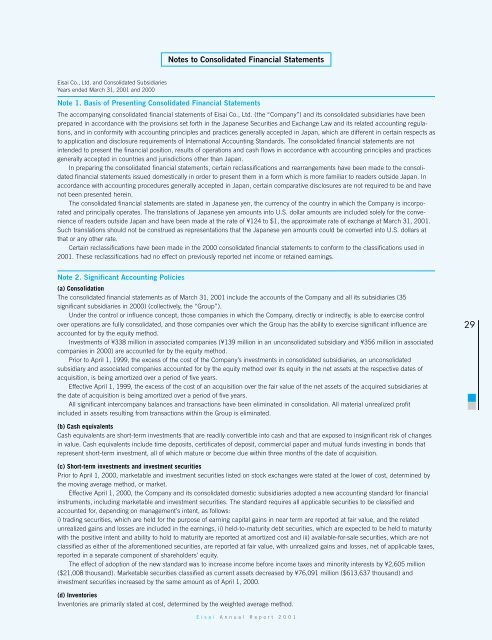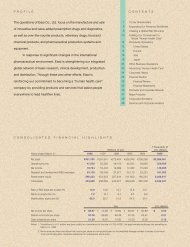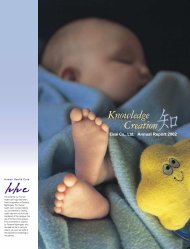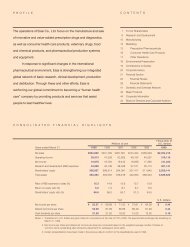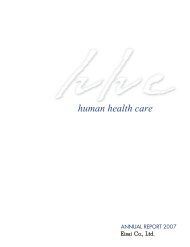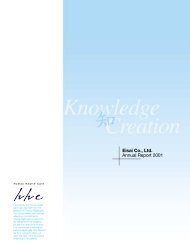Eisai Co., Ltd. Annual Report 2001 - Eisai GmbH
Eisai Co., Ltd. Annual Report 2001 - Eisai GmbH
Eisai Co., Ltd. Annual Report 2001 - Eisai GmbH
You also want an ePaper? Increase the reach of your titles
YUMPU automatically turns print PDFs into web optimized ePapers that Google loves.
<strong>Eisai</strong> <strong>Co</strong>., <strong>Ltd</strong>. and <strong>Co</strong>nsolidated Subsidiaries<br />
Years ended March 31, <strong>2001</strong> and 2000<br />
Notes to <strong>Co</strong>nsolidated Financial Statements<br />
Note 1. Basis of Presenting <strong>Co</strong>nsolidated Financial Statements<br />
The accompanying consolidated financial statements of <strong>Eisai</strong> <strong>Co</strong>., <strong>Ltd</strong>. (the “<strong>Co</strong>mpany”) and its consolidated subsidiaries have been<br />
prepared in accordance with the provisions set forth in the Japanese Securities and Exchange Law and its related accounting regulations,<br />
and in conformity with accounting principles and practices generally accepted in Japan, which are different in certain respects as<br />
to application and disclosure requirements of International Accounting Standards. The consolidated financial statements are not<br />
intended to present the financial position, results of operations and cash flows in accordance with accounting principles and practices<br />
generally accepted in countries and jurisdictions other than Japan.<br />
In preparing the consolidated financial statements, certain reclassifications and rearrangements have been made to the consolidated<br />
financial statements issued domestically in order to present them in a form which is more familiar to readers outside Japan. In<br />
accordance with accounting procedures generally accepted in Japan, certain comparative disclosures are not required to be and have<br />
not been presented herein.<br />
The consolidated financial statements are stated in Japanese yen, the currency of the country in which the <strong>Co</strong>mpany is incorporated<br />
and principally operates. The translations of Japanese yen amounts into U.S. dollar amounts are included solely for the convenience<br />
of readers outside Japan and have been made at the rate of ¥124 to $1, the approximate rate of exchange at March 31, <strong>2001</strong>.<br />
Such translations should not be construed as representations that the Japanese yen amounts could be converted into U.S. dollars at<br />
that or any other rate.<br />
Certain reclassifications have been made in the 2000 consolidated financial statements to conform to the classifications used in<br />
<strong>2001</strong>. These reclassifications had no effect on previously reported net income or retained earnings.<br />
Note 2. Significant Accounting Policies<br />
(a) <strong>Co</strong>nsolidation<br />
The consolidated financial statements as of March 31, <strong>2001</strong> include the accounts of the <strong>Co</strong>mpany and all its subsidiaries (35<br />
significant subsidiaries in 2000) (collectively, the “Group”).<br />
Under the control or influence concept, those companies in which the <strong>Co</strong>mpany, directly or indirectly, is able to exercise control<br />
over operations are fully consolidated, and those companies over which the Group has the ability to exercise significant influence are<br />
accounted for by the equity method.<br />
Investments of ¥338 million in associated companies (¥139 million in an unconsolidated subsidiary and ¥356 million in associated<br />
companies in 2000) are accounted for by the equity method.<br />
Prior to April 1, 1999, the excess of the cost of the <strong>Co</strong>mpany’s investments in consolidated subsidiaries, an unconsolidated<br />
subsidiary and associated companies accounted for by the equity method over its equity in the net assets at the respective dates of<br />
acquisition, is being amortized over a period of five years.<br />
Effective April 1, 1999, the excess of the cost of an acquisition over the fair value of the net assets of the acquired subsidiaries at<br />
the date of acquisition is being amortized over a period of five years.<br />
All significant intercompany balances and transactions have been eliminated in consolidation. All material unrealized profit<br />
included in assets resulting from transactions within the Group is eliminated.<br />
(b) Cash equivalents<br />
Cash equivalents are short-term investments that are readily convertible into cash and that are exposed to insignificant risk of changes<br />
in value. Cash equivalents include time deposits, certificates of deposit, commercial paper and mutual funds investing in bonds that<br />
represent short-term investment, all of which mature or become due within three months of the date of acquisition.<br />
(c) Short-term investments and investment securities<br />
Prior to April 1, 2000, marketable and investment securities listed on stock exchanges were stated at the lower of cost, determined by<br />
the moving average method, or market.<br />
Effective April 1, 2000, the <strong>Co</strong>mpany and its consolidated domestic subsidiaries adopted a new accounting standard for financial<br />
instruments, including marketable and investment securities. The standard requires all applicable securities to be classified and<br />
accounted for, depending on management’s intent, as follows:<br />
i) trading securities, which are held for the purpose of earning capital gains in near term are reported at fair value, and the related<br />
unrealized gains and losses are included in the earnings, ii) held-to-maturity debt securities, which are expected to be held to maturity<br />
with the positive intent and ability to hold to maturity are reported at amortized cost and iii) available-for-sale securities, which are not<br />
classified as either of the aforementioned securities, are reported at fair value, with unrealized gains and losses, net of applicable taxes,<br />
reported in a separate component of shareholders’ equity.<br />
The effect of adoption of the new standard was to increase income before income taxes and minority interests by ¥2,605 million<br />
($21,008 thousand). Marketable securities classified as current assets decreased by ¥76,091 million ($613,637 thousand) and<br />
investment securities increased by the same amount as of April 1, 2000.<br />
(d) Inventories<br />
Inventories are primarily stated at cost, determined by the weighted average method.<br />
<strong>Eisai</strong> <strong>Annual</strong> <strong>Report</strong> <strong>2001</strong><br />
29


